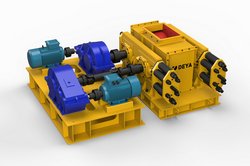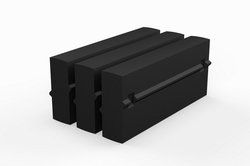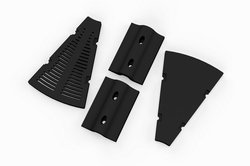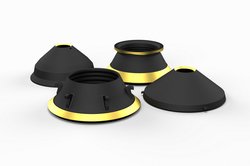River pebble crushing plant feasibility report
1. Selection of crushing equipment and process design
1.1. Background, raw material investigation and analysis
The particle size composition, stone quality, strength and collection method of the crushing material determine the selection of the crushing equipment and the crushing process.
To this end, a detailed investigation and analysis of the river pebbles revealed that there were a large number of river pebbles in the river channel along the project.
The river pebbles are with different sizes in the longitudinal slope of the river, some of them are above 350mm; while most of them are within the range of 50 to 350 mm, they are easy to collect.
Grain size composition:
Pebbles with a grain size of 5 to 50mm account for 5% to 10% of the total, pebbles with a grain size of 50 to 350mm account for 60% to 70%, and pebbles with a grain size of 350mm or more account for 20% to 30%.
River pebble stone quality:
After investigation and testing, more than 98% of the river pebbles are hard carboniferous core, with a very small amount of quartzite, etc.
The strength of river pebbles is over 150MPa. The pebbles in the natural riverbed are of different sizes, with those above 350mm in diameter accounting for 20%-30% of the total.
In order to reduce the difficulty and cost of crushing, the pebbles above 350mm in diameter are removed after comprehensive analysis and comparison.
For pebbles between 500 and 800 mm in diameter, the pile is dug on site and the larger stones are rolled to the edge of the pile and then removed by the excavator; for pebbles between 350 and 500 mm in diameter, a triangular steel pipe grate is welded to the cargo box of the dump truck.
Several sections of quarry were identified, taking into account the ease of collection, distance from the crushing yard, size of the grains and the amount that could be mined.
After the quarries were identified, further excavation surveys and calculations were carried out to ensure that the quarry volume met the demand.
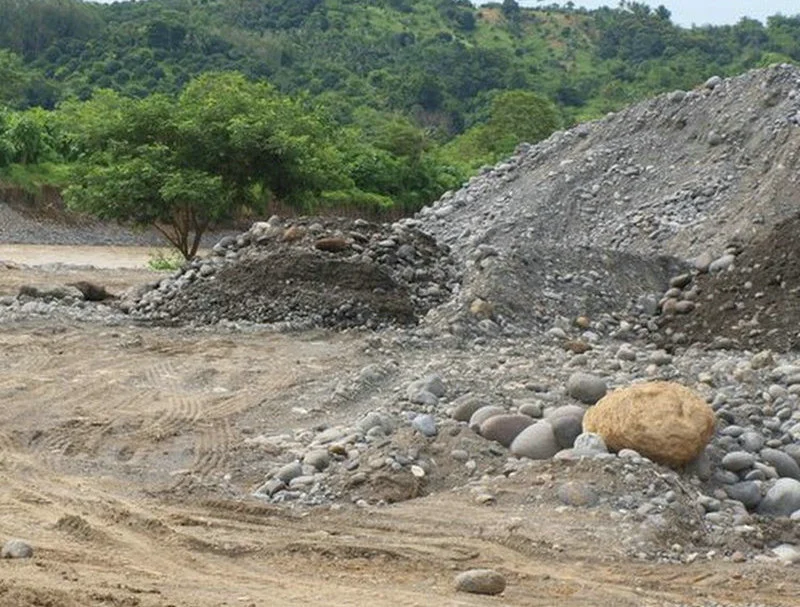
1.2. Desgin of river pebble crushing plant production line
Considering that the project requires 40,000 m3 of crushed stone and 28,000 m3 of sand, it is difficult to feed the material from outside, a combined sand and gravel production line is used to produce sand and gravel at the same time.
The production process can be adjusted according to the amount of sand and gravel required in each period to meet the construction needs. The main crushing process is shovel loading, primary crushing, secondary crushing, screening, sand washing, and the finished qualified sand and gravels.
1.3. Confirmation of the crushing equipment and process capacity
According to the project plan, 6.8 million m3 of sand and gravel as long as it can be completed within 5 months, can meet the needs of the schedule. The construction section of the project has a pass in the middle, the pass needs to wait until the main project on both sides of the pass is completed, that is to say, the late project at the pass can be open to material trucks.
Considering this feature of the project, a set of crushing equipment was set up on each side of the pass at an appropriate location. Considering that the installation and commissioning needs about 40 days, the actual crushing time is only 3.5 months, considering the effective working time of 25 days per month, the average operating time of 12 hours per day, the required hourly output is 6.8 x 10000 ÷ [(25 x 3 + 15) x 12 x 2] = 31.5m3/h.
According to the crushing equipment type and output, the choice of 50t per hour (33m3) processing capacity of 2 sets of combined sand and gravel production line.
In addition, considering the extreme hardness of the river pebbles and the relatively low crushing efficiency, a graded crushing line was selected, i.e. a jaw crusher was used first for coarse crushing and then an impact crusher for secondary crushing.
1.4. The primary crushing equipment, i.e. the jaw crusher, selection conditions
A. PE series capable of crushing high hardness pebbles with high local pressure, thick jaw plates, large jaw span, large crushing bending moment and narrow and deep jaw opening;
B. A capacity of 50t/h, i.e. not less than the combined production line’s overall capacity;
C. A maximum feed size of 350mm.
According to these conditions, the PE-400×600 jaw crusher was selected, with a capacity of 60t/h, a maximum feed size of 340 mm, a discharge size of 40-100 mm and a motor power of 30kW, which fully meets the above conditions.
1.5. Secondary crushing equipment, i.e. impact crusher model selection conditions
A. The ability to crush high strength river pebbles;
B. As a final stage of crushing, the particle shape of the crushed stone can meet the quality requirements of the relevant highway engineering specifications for aggregate, and the crushed stone long strips and flakes can be controlled within a low content;
C. The wear parts are easy to replace and wear-resistant;
D. The output is above 50t/h.
According to these conditions, the PF-1007 impact crusher was selected, with an inlet size of 400 mm x 730 mm, a maximum feed edge length of 300 mm, a production capacity of 50 t/h and power of 45 kW.
1.6. Vibrating screen selection conditions
A. Three types of material must be available, i.e. sand below 5 mm, gravel from 5 to 20 mm and gravel from 20 to 40 mm;
B. taking into account the needs of the project, the number of mixer hopper preparation and other factors, 3 layers of screens with holes of 5, 20 and 40 mm are required;
C. Water supply equipment can be added for washing during the screening process (screening is difficult when the raw material is wet after crushed).
According to these conditions, circular vibrating screen 3YK1237 was selected, its processing capacity is 70t/h, motor power 7.5kW, inclination angle 20 °, amplitude 8mm, screen surface specifications 1200mm x 3700mm.
1.7. Sand washer selection conditions
According to the total output requirements, the bucket type sand washer was selected, model XS29, processing capacity of 50t/h or more, bucket diameter 2900mm, speed 0.8 ~ 1.2RPM, motor power 7.5kW.
1.8. Belt conveyors selection conditions
Considering the characteristics of wet raw material and easy to slide, the uniform width of 600mm belt is used, and the inclination of the belt machine is controlled within 18°.
The length of two belts from jaw crusher to impact crusher and from impact crusher to vibrating screen is selected as 15m; the length of belt from vibrating screen and from sand washer is 20m (mainly considering the distribution of material pile). Each belt motor power 5.5kW, a total of 6×5.5 = 33kW, conveying capacity of 100t/h.
1.9. Other equipment configuration
Configure 50t forklift 1 set, mainly used for loading and moving materials; configure 200kW transformer 1 set to power the whole plant.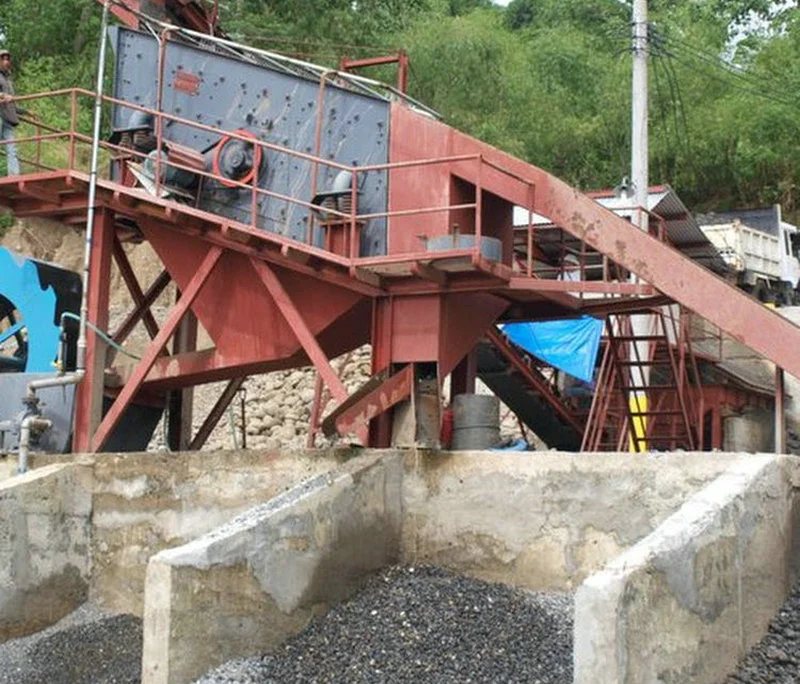
2. Issues to be noted in equipment installation and commissioning
2.1. Installation of jaw crusher
A. Use shovel to load material and rely on gravity to discharge material.
The material is loaded by manual control of flow rate, the loading hopper is welded on site (steel plate plus steel section), in the shape of vertical inclined skip, the inclination angle is 30°, it is conducive to the automatic downward movement of river pebbles, the hopper is 6m high from the ground, behind the hopper is filled with river pebbles to make the shovel loading ramp-way.
B. Inlet feeding speed control
A rotatable block is set at the hopper outlet, and the amount of feeding is controlled manually by using the lever principle to prevent too fast feeding from blocking the crusher inlet, and to prevent low output and waste caused by too slow feeding.
C. Jaw crusher jam prevention.
The jam may be caused by too fast feeding and the entry of oversized stones. In order to reduce the jam, on the one hand, the entry of oversized stones should be controlled.
On the other hand, the speed of discharging material should be controlled, but there are still a small amount of jamming phenomenon despite of various measures.
In order to reduce the processing time of jamming and minimize the impact, a small gantry and a hand-pull hoist are added to the jaw crusher, and a special fixture is set under the hoist, which can be used to take out the stones as soon as possible once the machine is jammed.
In addition, this lifting equipment provides conditions for quick replacement of jaws, so that the time for replacing jaws is greatly reduced.
D. Iron removing
In the actual production, iron parts often fall into the raw material and then enter the impact crusher, causing the crusher to accelerate damage.
In order to avoid such things, strong magnets are set above the belt machine near the exit of jaw crusher, once any iron parts pass through will be sucked away by the magnets, which can completely avoid iron parts from entering and prevent the damage of iron parts to the equipment.
2.2. Installation of impact crusher
A. Set up a protective cover above the feed opening to prevent flying material from injuring people. Because the impact crusher relies on high-speed rotating striking stone, line speed is more than 30m/s, the speed of flying stone is very high, and it is easy to hurt people.
B. There are a lot of flying materials flying out of the discharge port of the impact crusher at a very high speed. In order to prevent a lot of flying materials from damaging the belt of the belt conveyor, it is necessary to add a baffle plate and to check it frequently and replace it in time once it is damaged to prolong the life of the belt.
C. The motor axis and the rotor axis of the crusher must be aligned parallel and fixed reliably during installation, otherwise there will be frequent problems.
2.3. Issues to be noted in the installation and use of vibrating screen
A. The drop-off position of belt conveyor on the vibrating screen should be equipped with an easily replaceable steel mesh (400mm×400mm), it reduces the damage rate of the local screen mesh.
If no special protection net is added, the screen at the drop material will be damaged within one shift, resulting in constant replacement of the screen.
B. Add a flushing water spray pipe above the vibrating screen for cleaning gravels and remove the impurities, also good for the screening.
C. Vibrating screen discharge chutes design should be reasonable and firm, and the material should be discharged smoothly without blocking.
2.4. Issues to be noted in the installation of sand washer
A. The top height of the sand washer pool should be lower than the vibrating screen outlet. Fill a large amount of water from the vibrating screen to carry sand smoothly into the sand washer pool.
B. The drainage port of the sand washer should be located in the upper part of the pool as far as possible, and the size of the drainage port should be combined with the amount of water intake and the thickness of the drainage port screen, to ensure both smooth drainage without overflowing and fine sand is not taken away.
C. The reducer should be placed below or behind the impeller shaft gear, so that the base of the reducer is only shear or pressure, absolutely not to make the base of the reducer local tension. Because the reducer base and shell are cast iron, brittle, local tension resulting in stress concentration, very easy to damage.
D. Sewage treatment. The construction site is in the scenic area, sand washing sewage must be treated before discharge into the river. 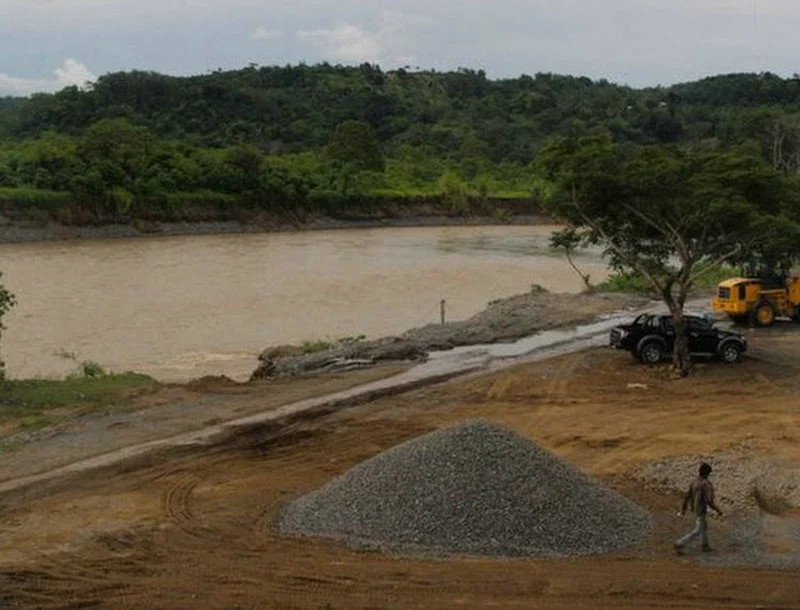
3. Pebble crushing plant economic and social benefit analysis
3.1 Economic benefits
The project uses 40,000m3 of crushed stone and 28,000m3 of sand.
3.1.1 The cost of crushing crushed stone and sand using river pebbles is as follows:
A. Production cost. Equipment investment of 400,000 yuan per set, 2 sets total 800,000 yuan, depreciation by 5 years, equipment depreciation of 160,000 yuan per year. Total installed capacity of crushing equipment 260kW, electricity cost is 68000 m3 ÷ 31 m3 / h × 2 × 0.8 × 260 = 228129 yuan. 50t shovel use fee is calculated on the basis of 4 months, 2.5 million yuan per month, 2 sets, a total of 4 × 2.5 × 2 = 200,000 yuan.
B. Labor costs. Each set of equipment 6 people, a total of 12 people, monthly wages of 3,000 yuan, a total of 3,000 × 12 × 4 = 144,000 yuan.
C. Raw material transportation costs, collection costs of 10 yuan / m3, loss factor according to 1.05, a total of 68,000 × 1.05 × 10 = 714,000 yuan.
D. Equipment installation and dismantling transportation costs of 50,000 yuan per set, a total of 100,000 yuan. The total cost is 160000 + 228129 + 200000 + 144000 + 714000 + 100000 = 1546129 yuan.
3.1.2 If the use of material outside the mountain, the price of crushed stone outside the price of 85 yuan / m3, the price of sand outside the price of 130 yuan / m3, the total cost of 85 × 40000 + 130 × 28000 = 7040000 yuan.
The direct economic benefit of using river pebbles to produce crushed stone and sand is 7040000-1546129 = 5493871 Yuan.
3.2 Social benefits
First, on-site processing production, can avoid a large number of transport sand and gravel materials on the original landscape road damage.
Second, through the planned mining of river pebbles, dredging the river channel, conducive to flooding during the waterfall rain.
Third, waste into treasure, river pebbles continue to pile up, occupying a large amount of arable land, reasonable mining and use of river pebbles will greatly reduce the occupation of arable land.
Contact us to customize the crushing plant for you.

